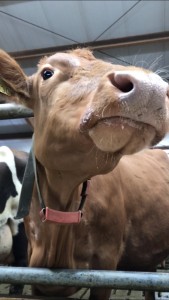Happy Cows
After working on a sustainable and organic farm in Minnesota last summer, sustainable and efficient practices has been something very keen to me. When visiting Akureyi, the CELL group had the opportunity to visit Kaffi Ku, the “Happy Cow” cafe. The cafe was connected to a very high tech cow barn. The barn was ran by all these impressive technologies, such as an automatic milker, feeder (which their diet was 80% grass), and groomer, as well as collars so that no cow was milked too often. All these machines were impressive, allowing for very efficient milking with hardly any man power. The barn also had a good amount of space for the 150 cows. There was space for them to walk around and mattresses for them to sleep on. From what I could see, it did seem like these were “happy cows”.
While Kaffi Ku’s operation was very efficient and relatively sustainable, I feel there are some practices they could improve on. First off, there is a quota for how much milk each Icelandic dairy farm can produce dependent on how many cows they have, and Kaffi Ku always exceeds that quota. Where is that left over milk going? Is it just being thrown out? Is it being sold to other farms? Exported? During our visit, they asked us if we had any sustainable ideas on what they could use the excess milk for. I know it is in their best intentions to not waste milk, but I have an itch that is what it currently happening.
Second, I feel the technology causes for a separation between the cows and the humans. Call me old school, but I love having a relationship with the animals. I had 12 hilarious pigs on that Minnesotan farm and while feeding them by hand, moving them, and filling their water troughs was hard work, I felt it caused for respect between me and the pigs. Modern day agriculture is all about yields and it is sad that we view these animals as money makers rather than living beings.
One last thing I would like to touch on is the technology promotes further competition between farmers. The technology we saw in Kaffi Ku had to of cost a fortune. Yes, it allows for them to produce much more milk, but in the end I think this technology will cause for an oligopoly in Iceland. Only the farmers who can afford these technologies will be able to compete, causing for the others to lose their jobs and lifestyles. Which actually brings up another thought I have in regards to dairy consumption in Iceland – there are about 300,000 people in Iceland, just how much dairy does Iceland actually need? Is it really necessary to have all this high tech machinery to produce as much milk as possible if they just end up exceeding the quota?

Kevin Katz
